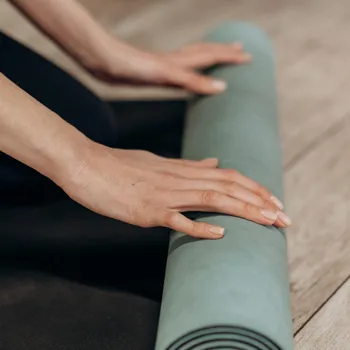Unlock Wellness: 7 Mind-Body Techniques for Inner Harmony. Dive into ancient practices for modern well-being
In today's fast-paced world, finding inner peace and maintaining overall well-being can feel
like a herculean task. Many of us are constantly juggling work, family responsibilities, and social commitments, often leaving little time for self-care. The result?

Increased stress, anxiety, and a general feeling of being disconnected from ourselves. Thankfully, there's a growing awareness of the powerful connection between the mind and body, and an increasing number of people are turning to mind-body practices to cultivate wellness.
These techniques, rooted in ancient traditions and backed by modern science, offer a holistic approach to health, addressing not only physical symptoms but also emotional and mental well-being.
Mind-body practices work by fostering a deeper connection between our thoughts, feelings, and physical sensations. This connection allows us to become more aware of our body's signals, helping us to respond to stress more effectively and promote overall balance.
When we are mindful of our body's needs, we can make healthier lifestyle choices, improve our emotional regulation, and enhance our overall sense of well-being. The integration of mind and body allows for a more harmonious existence, where inner peace becomes the foundation for a fulfilling life.
It's about understanding that our mental state directly impacts our physical health, and vice versa. Taking care of one strengthens the other.
Here are seven effective mind-body techniques you can easily incorporate into your daily routine to experience the benefits of this powerful connection:
Yoga
More than just twisting into pretzel-like poses, yoga is a comprehensive practice that combines physical postures (asanas), breathing techniques (pranayama), and meditation. Yoga helps to improve flexibility, strength, and balance, while also calming the mind and reducing stress.

The synchronized movement and breathwork create a meditative state, promoting mental clarity and emotional stability. Regular yoga practice can also lower blood pressure, improve sleep quality, and boost immunity.
There are various styles of yoga to choose from, catering to different fitness levels and preferences. From gentle Hatha yoga to more dynamic Vinyasa flow, there's a style for everyone to enjoy.
Starting with beginner-friendly classes and gradually progressing is a great way to reap the rewards of this ancient practice. The emphasis on mindful movement makes it a perfect tool for connecting with your body and letting go of mental clutter.
Meditation
Meditation involves training your mind to focus and redirect your thoughts. It can be practiced in many ways, from sitting quietly and focusing on your breath to using guided visualizations or chanting mantras.

Regular meditation practice has been shown to reduce anxiety, improve concentration, and promote feelings of calm and well-being. Even just a few minutes of meditation each day can have a significant impact on your mental and emotional health.
There are numerous apps and online resources available to guide you through different meditation techniques. Experiment with different methods to find what resonates with you best. The key is consistency – making meditation a regular part of your daily routine to experience its cumulative benefits.
The focused attention helps to quiet the mental chatter and create a sense of inner stillness.
Deep Breathing Exercises
Often overlooked, simple deep breathing exercises are a powerful tool for managing stress and promoting relaxation. When we're stressed, our breathing becomes shallow and rapid, which can further exacerbate feelings of anxiety.

Deep breathing, on the other hand, activates the parasympathetic nervous system, which is responsible for the "rest and digest" response. This helps to slow down the heart rate, lower blood pressure, and promote a sense of calm.
There are many different deep breathing techniques, such as diaphragmatic breathing (belly breathing) and alternate nostril breathing. These can be practiced anywhere, anytime, making them a convenient and accessible way to manage stress on the go.
Taking a few moments throughout the day to focus on your breath can make a significant difference in your overall well-being.
Tai Chi
This ancient Chinese martial art involves slow, flowing movements combined with deep breathing and meditation. Tai Chi is a low-impact exercise that improves balance, coordination, and flexibility. It also helps to reduce stress, improve sleep quality, and boost the immune system.
The gentle, rhythmic movements of Tai Chi are calming and meditative, promoting a sense of inner peace and tranquility. Tai Chi is suitable for people of all ages and fitness levels, making it an excellent option for those looking for a gentle yet effective mind-body practice.
The emphasis on mindful movement cultivates body awareness and enhances physical function. The flowing nature of the practice promotes a sense of grace and ease.
Qigong
Similar to Tai Chi, Qigong is another ancient Chinese practice that involves coordinating breathing, movement, and meditation. Qigong focuses on cultivating and balancing the body's energy (qi) to promote health and well-being.
There are many different styles of Qigong, each with its unique set of movements and exercises. Regular Qigong practice can improve circulation, reduce pain, boost immunity, and enhance mental clarity.
The gentle movements and breathing techniques are calming and restorative, promoting a sense of vitality and well-being. Like Tai Chi, Qigong is suitable for people of all ages and fitness levels. The practice emphasizes the flow of energy throughout the body, promoting balance and harmony.
Progressive Muscle Relaxation (PMR)
PMR involves systematically tensing and relaxing different muscle groups in the body. This technique helps to release muscular tension, reduce anxiety, and promote relaxation.

By consciously focusing on the sensation of tension and release, you become more aware of your body's physical state and learn to identify early signs of stress. PMR can be practiced anywhere, anytime, and is a particularly helpful technique for managing stress before bed, leading to better sleep.
It helps to cultivate body awareness and enhances your ability to relax at will. The systematic approach makes it easy to follow and effective for releasing physical tension.
Mindful Walking
Walking is a simple and accessible form of exercise that can be easily transformed into a mind-body practice by incorporating mindfulness. Instead of rushing from point A to point B, take the time to notice your surroundings, feel the ground beneath your feet, and pay attention to your breath.

Mindful walking allows you to be present in the moment and appreciate the simple act of moving your body. It helps to reduce stress, improve mood, and enhance your connection with nature. You can practice mindful walking in a park, on a beach, or even on your way to work.
The key is to be fully present and engaged in the experience of walking. The focus on sensory awareness brings you into the present moment and allows you to disconnect from mental worries.
Incorporate mind-body practices for improved well-being and happiness
Incorporating these mind-body practices into your daily routine can lead to significant improvements in your overall well-being. Start slow, be patient with yourself, and find the techniques that resonate with you.

The journey to wellness is a personal one, and the key is to find what works best for you and make it a sustainable part of your lifestyle. As you deepen your connection with your mind and body, you'll discover a greater sense of inner peace, resilience, and overall well-being.
Remember that consistency is key, and even small, regular efforts can yield significant results over time. Embracing these practices is an investment in your health and happiness.
AI Generated Content. Glance/InMobi shall have no liability for the content











